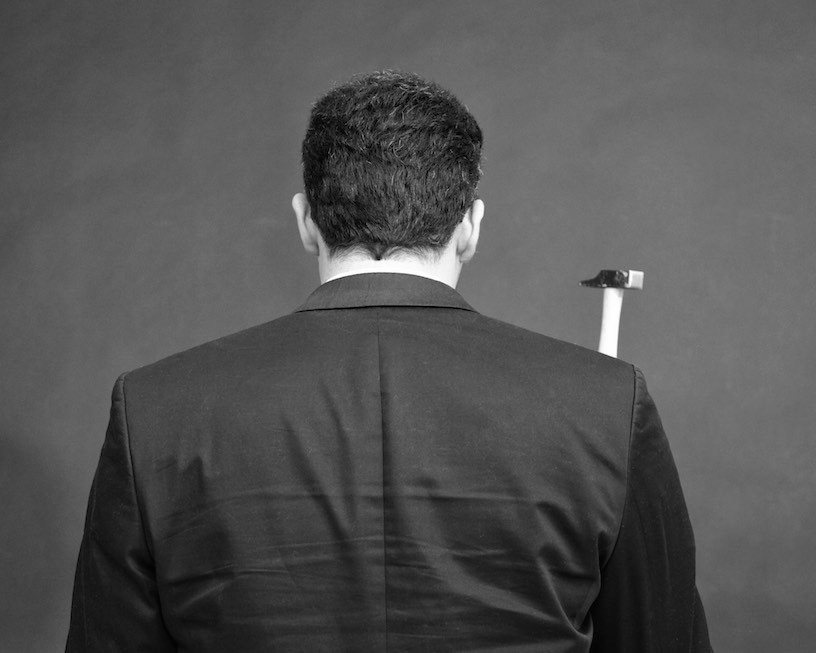mounir fatmi est né à Tanger au Maroc, en 1970. À l’âge de quatre ans, sa famille déménage à Casablanca. A dix-sept ans il part à Rome où il s’inscrit à l’école libre de nu et de gravure à l’académie des beaux-arts, puis à l’école des beaux arts de Casablanca et finalement à la Rijksakademie à Amsterdam.
Il passe son enfance dans le marché aux puces du quartier Casabarata, un des quartiers le plus pauvres de la ville de Tanger où sa mère vendait des vêtements pour enfants. Un environnement qui multiplie jusqu’à l’excès les déchets et les objets de consommation en fin de vie. L’artiste voit par la suite cette enfance comme sa première éducation artistique et compare ce marché aux puces à un musée en ruine. Cette vision a également valeur de métaphore et exprime les aspects essentiels de son travail. Influencé par l’idée de médias morts et l’effondrement de la civilisation industrielle et consumériste, il développe une réflexion sur le statut de l’œuvre d’art entre Archive et Archéologie.
Il utilise des matériaux obsolètes tels que les câbles d’antenne, les anciennes machines à écrire, ou les cassettes VHS, et travaille sur la notion d’une archéologie expérimentale en examinant le rôle de l’artiste au sein d’une société en crise. Il joue des codes et préceptes de cette dernière sous le prisme de la trinité Langage, Architecture et Machine. Il interroge ainsi les limites de la mémoire, du langage et de la communication, tout en réfléchissant sur les matériaux en cours d’obsolescence et à leurs avenirs incertains. La recherche artistique de mounir fatmi, constitue une pensée sur l’histoire des technologies et leurs influences dans la culture populaire. Il faut voir ainsi dans ses œuvres, de futures archives de médias en construction. Bien qu’ils marquent des moments clés de notre histoire contemporaine, ces matériaux techniques remettent également en question le transfert de connaissances, le pouvoir suggestif des images et critiquent les mécanismes illusoires qui nous lient à la technologie et aux idéologies.
Depuis 2000, les installations de mounir fatmi ont été sélectionnées dans plusieurs biennales, la 52e et la 57e Biennale de Venise, la 8e Biennale de Sharjah, la 5e et la 7e biennale de Dakar, la 2e Biennale de Séville, la 5e Biennale de Gwangju, la 10e Biennale de Lyon, la 5e triennale d’Auckland, la 10e et 11e biennale de Bamako, la 7e Biennale d’architecture, Shenzhen, à la triennale de Setouchi et la triennale Echigo –Tsumari, au Japon. Son travail a été présenté au sein de nombreuses expositions personnelles, au Migros Museum für Gegenwarskunst, Zürich. Mamco, Genève. Musée Picasso, la guerre et la paix, Vallauris. Fondation AK Bank, d’Istanbul. Museum Kunst Palast, Düsseldorf et au Goteborg Konsthall. Il a participé à plusieurs expositions collectives au Centre Georges Pompidou, Paris. Brooklyn Museum, New York. Palais de Tokyo, Paris. MAXXI, Rome. Mori Art Museum, Tokyo. MMOMA, Moscou. Mathaf, Doha. Hayward Gallery et Victoria & Albert Museum, Londres. Van Abbemuseum, Eindhoven, au Nasher Museum of Art, Durham et au Louvre Abu Dhabi.
Il a reçu plusieurs prix dont le Uriöt prize, Amsterdam, le Grand Prix Léopold Sédar Senghor de la 7e Biennale de Dakar en 2006, le prix de la Biennale du Caire, en 2010, ainsi que le Silver Plane Prize de la Biennale de l’Altai, Moscou en 2020.
